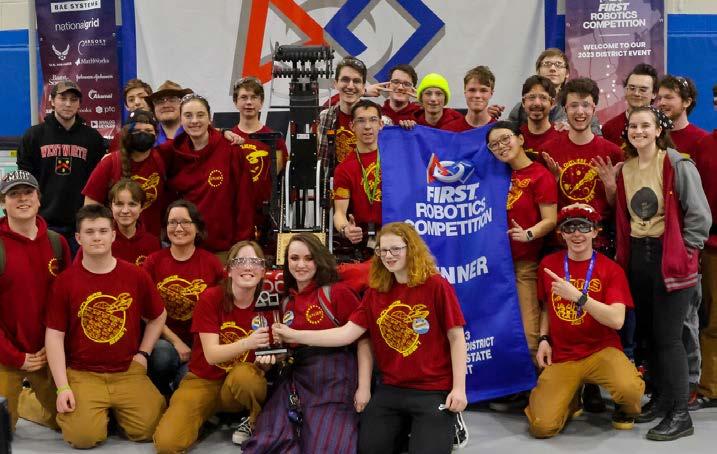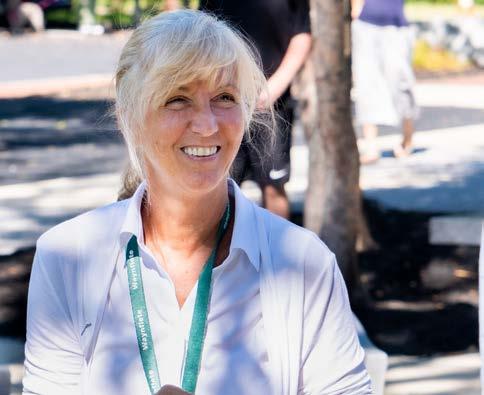
4 minute read
AUTOCAD DRAFTING
Upper School students are benefiting from the new curriculum as well. Department offerings such as Programming for Scientists and Engineers and Engineering 1 allow students to learn and apply a variety of programming techniques to solve real-world problems, while Design and Fabrication introduces them to tools that can be used to transform virtual models into tangible objects.
Amory points out that the new computer science and engineering courses serve two distinct, but equally important, purposes. “For those students interested in an engineering career, we provide the skills they need to thrive in college. Studies indicate that 50 percent of engineering majors change majors or drop out prior to graduation, so gaining proficiency in these areas prior to entering college is key.” But every student benefits from exposure to these courses, Amory hastens to add. “The 21st-century skills that students need will increasingly be intertwined with computer science and engineering,” he asserts. “No matter your major, you need to be able to understand programming and work with engineers.”
Advertisement
It’s this belief that drives Amory’s work outside the classroom as leader of the community’s wildly successful FIRST Robotics team “The Outliers.” He has been affiliated with the team since its founding in 2015 by a student at Baxter Academy—his previous employer—and has watched it grow steadily to incorporate students from beyond Baxter. He is thrilled that Waynflete students now have the opportunity for full-fledged participation. “The FIRST Robotics program is unlike anything you can find in school,” says Amory. “The program demands a lot of time from both the kids and the mentors, but it’s an incredibly compelling means of getting kids involved in a large project solely for the sake of learning.” And the computer science and engineering skills participants gain are just the beginning, he says.
“The amount of learning in a FIRST team is way beyond what a student can learn in the classroom,” Amory insists. “The level of technology that students are working with is unbelievable. As team members, they decide what their robot will do and then figure out how to make that happen.” And in addition to coding and programming skills, says Amory, students also develop proficiency in mentoring and leadership as older team members take on responsibility for teaching incoming members.
And although the team does compete, Amory says that the extrinsic motivation pales in comparison to the sense of community and camaraderie the students discover. “Team members work with other FIRST team students from all over the country—it’s a very collaborative environment,” he explains.
And the dedication of the participants is unparalleled. “The students spend between 500 and 1,000 hours on robotics outside school, with some going as high as 1,200, completely voluntarily. It’s inspiring.”
Many team members also go on to highly successful careers in industry, says Amory. “I’ve had team alumni tell me they’ve learned as much from their participation in the robotics program as from their entire education.”
Connecting classroom and community
While Waynflete faculty and administrators delight in the idea of training more students to enter STEM fields, they also recognize that careers in tech aren’t for everyone. To a person, however, they insist that an understanding of technology’s role in our lives is essential for anyone living in today’s digitally dominated world.
“I don’t think that every student in my classes will get hooked on computer science, but they will all be consumers of technology and will almost certainly be confronting ethical and privacy concerns,” says Bartnick. “Being conscious consumers is just as important as being creators. And if nothing else, when these kids are using a computer program, they will hopefully think about the data that program is using and ask themselves what purpose it is serving. That’s vitally important.”
Geoff Wagg echoes that sentiment. “I don’t want our graduates to merely be consumers of this allencompassing technology; I want them to understand how it works and be able to control their own destiny,” he notes. “And that requires an understanding of the logical thinking and programming element as well as an understanding of how design thinking and engineering work. The skills that come along with design thinking, engineering, and programming—the problem-solving— are all essential skills that kids need now and will need in the future. And you want to get them excited about that at as young an age as possible.”
“Technology is a big part of life in all professions,” notes Upper School Director Asra Ahmed. “I believe that by opening these doors for our students, we will encourage them to look at college and careers with a fresh eye.” All the soft skills students develop in the humanities are still essential, Ahmed insists, but they are increasingly touched by technology.
“My hope is that every Upper School student will have at least one semester of experience in both engineering and computer science so that they understand the application of these fields to life,” Ahmed concludes. “That way, when they get to college and encounter these disciplines, they won’t be intimidated. The future is here, and our eyes need to be wide open so that we can prepare students for what’s to come.”
AFTER 30 YEARS of dedicated service, Carol Titterton is stepping away from her beakers and microscopes at the end of the 2022–23 academic year. She hopes to continue teaching part time at the college level, giving her more time to spend with Peter Hamblin, her husband and former Waynflete associate head. This is a moment to celebrate Carol’s many years of extraordinary work as a teacher, advisor, department chair, and co-advisor to the senior class.

Carol’s impact on students and the school as a whole is legendary. Graduates far and wide tell stories of her quick-wittedness, demanding teaching style, and fierce advocacy for her students and advisees. As a classroom teacher, Carol is always one to keep her content relevant and exciting. She set a high bar for students and was willing to stand shoulder to shoulder with them as they strove to meet her expectations (many graduates who have gone on to majors and careers in science attribute their interest and success in part to Carol). Along with her colleague Wendy Curtis, she co-led our perennially victorious Science Olympiad team against teams from across the state.
Carol’s personal style of deep devotion to her students—mixed with a propensity to say whatever pops into her mind, no matter how it might land on her audience—has earned her a devoted following. Over the past three decades, students have learned that her quick wit and willingness to poke fun is in fact a disguise for someone who cares deeply for every one of them.
Thank you, Carol, for all you have done for our students and our community!










